Blue is the Warmest Color: Adaptation and Audience
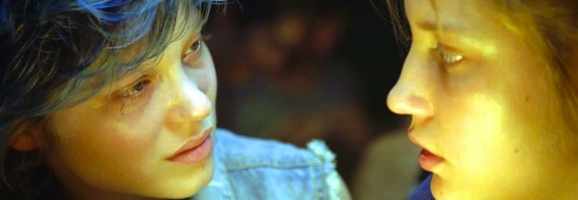
This post contains spoilers.
In 2010, French graphic artist, Julie Maroh published the graphic novel Blue is the Warmest Color. The graphic novel is a lesbian coming of age love story where one of the protagonists, Emma, relives her relationship with Clementine through her diary after she has passed away. Shortly after the release of the graphic novel, a film adaptation was started by Abdellatif Kechiche, who was the director, writer, and one of the producers of the film. After La Vie d’Adèle – Chapitres 1 & 2, translation Life of Adele – Chapters 1 & 2, was completed, the film was shown at the Cannes festival in 2013. The film received wide-spread acclaim, unanimously winning the Palm d’Or, which for the first time was awarded not only to the director but to both of the lead actresses, Adele Exarchopoulos and Lea Seydoux. In the US, the film was renamed to Blue is the Warmest Color.
Even with all the acclaim though, controversy over Blue is the Warmest Color quickly spread for the film’s long and explicit sex scenes. Exarchopoulos and Seydoux also made comments criticizing Abdellatif Kechiche’s rude and manipulative behavior on set of the film. Julie Maroh, herself, has criticized the film for the sex scenes being unrealistic and for the lack of a lesbian being involved at all in the creative and filmmaking process (neither Exarchopoulos or Seydoux are lesbians). Despite the controversy though, the film still continues to be received highly and it has brought wider recognition and acclaim to Maroh’s graphic novel.
As with every adaptation, there are always varying degrees of fidelity. Some adaptations are nearly line for line copies of the original source, and others may completely omit many things in the original source. Blue is the Warmest Color is somewhere in the middle of these two extremes. The plot of Maroh’s graphic novel and multiple parts of the story are present in Kechiche’s film, especially in the first half of the movie.
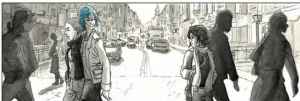
For example, similar shots were used to emulate a few of the panels in the graphic novel, most notably them passing on the street before they actually met and then Adele (Clementine) touching herself thinking about the “blue haired girl” she passed on the street. Adele’s friends rejecting her for hanging out with Emma, even though they had no proof that she was a lesbian, and in both versions of Blue is the Warmest Color, Adele wants to be a teacher and Emma aspires to be an artist.
However, the differences in the plot from one to the other are noticeable and significant. These differences greatly affect the interpretation of the story, especially when considering the audience the graphic novel was made for and the audience the film was made for.
Differences in Adaptation – Graphic Novel
Julie Maroh’s Blue is the Warmest Color is written and presented in a way where the target audience is supposed to be young adults who are already openly gay, struggling with their own sexuality, and straight people. The graphic novel has a unique and immersive art style, with carefully drawn characters and environments; the style is easy to follow and understand as the reader is becoming immersed in Clementine and Emma’s world.
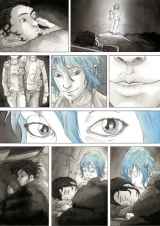
The art is in color when in the present day, following Emma reading Clementine’s diary, and then black and white when the audience is being shown the past. When the past is being shown, Maroh puts in a few spots of a bright blue in the midst of the grayscale black and white, most notably with Emma’s hair. “We follow the events of the past through Clementine’s diary,” Julie Maroh says in her interview with “Salon”, “but our memory never fully remembers everything. We always remember specific details… a light, a smell, a gesture, an object. Among the black-and-white imperfect memories of Clementine, the touches of blue are there to evoke strong details that left their mark on her.”
As time moves forward in Blue is the Warmest Color, the color palette starts to expand more, adding more color with each section of the story as it gets closer to the present. The increase in color is a nice and effective visual way to show time moving towards the present in the graphic novel. The story also doesn’t rely on complex metaphors or a complicated plot. It’s easy to read through and understand since the characters feel realistic and relatable to the average audience, making it an ideal read for a young adult audience.
As stated earlier, Blue is the Warmest Color has similarities and differences in it’s adaptation. The characterization is similar between Clementine and Emma in both versions. Clementine is a younger girl who aspires to become a teacher and live a stable and secure life. Her family is middle/low-class, as we can see from their concern about Emma trying to make a living off of painting (see page 121 of graphic novel). While the graphic novel touches on this characterization, the film explores this more by going in-depth with the dinner scenes in the film. Adele’s parents stress the importance of having a good stable job, like Adele being a teacher, when they learn about Emma working as an artist.
With Emma’s characterization, the audience can immediately tell that she is quirky and outgoing in both the graphic novel and film. She stands out at the gay bar by ordering strawberry milk (not a common drink to get at a bar), and makes herself standout very clearly with her bright blue hair. In the film, Abdellatif Kechiche expands on the class differences more by showing Emma’s family as liberal and more high-class. For example, while Adele’s family eats spaghetti and talks about needing a stable job, Emma’s family eats seafood and talks about the arts and culture.
One of the most notable differences in terms of adaptation is the ending of the graphic novel and the film. In the graphic novel, Clementine cheats on Emma with a man named Antoine. Emma dumps Clementine and kicks her out of her apartment. This sends Clementine on a downward spiral of depression and drug addiction. Eventually, they meet again at an ocean because one of Clementine’s friend, Valentin, set her up to meet her there without knowing. Emma forgives Clementine and they embrace and start to make out. Clementine then gets a heart attack from her poor health and she is in the hospital dying. Clementine gives Emma a note saying that she wants her to have her diaries, then the story ends with Clementine finishing the diaries.
This ending is definitive. The audience knows exactly where Emma and Clementine’s relationship ends and the audience has closure with what they need to know about Emma and Clementine’s individual life and their lives together. However, the film isn’t so simple with it’s ending.
Differences in Adaptation – Film and Why All of This Matters
In the film, Adele (Clementine) still cheats on Emma and Emma kicks her out of the apartment. Adele still gets depressed, but she doesn’t get addicted to drugs like in the graphic novel. They meet again at a café and Adele tries one last time to make Emma fall in love again, forcing her to touch her and kiss her. Emma has since gotten another girlfriend who has children and has started settling down as a family. She pushes Adele away and says that she would still like to see Adele but only as friends. Emma invites Adele to meet her at an art showing and when Adele goes she see’s that Emma is still using her nude paintings of Adele as one of her main paintings. The two talk for a bit, but then Emma leaves her to talk to other people. A young man comes up to Adele and talks to her, but Adele leaves the moment is attention is taken away from her. Adele briefly congratulates Emma on her work and then leaves the art showing. The film ends with Adele walking down the side-walk away from the camera, symbolizing her moving on with her life.
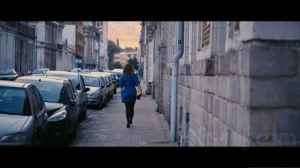
In terms of the artistic style of the film, Abdellatif Kechiche took the presentation and art direction in a much different way. There isn’t any sense of flashbacks or reminiscing in his adaptation. The film feels like it is being told in the present time closely following the life of Adele as it happens before the audiences eyes. The film is very naturalistic, relying on the use of natural light, long takes and scenes, and a lack of a soundtrack. There are not many scenes in the film that takes you out of the immersion of the film (excluding the sex scenes). The original French title even reflects this naturalistic feeling: La Vie d’Adèle – Chapitres 1 & 2, translation: Life of Adele – Chapters 1 & 2. Film critic Darragh O’Donoghue writes, “His [Kechiche’s] staging of long, partly improvised scenes with handheld cameras allows him to remain true to the language of gaze, gesture, and touch. He goes further by removing the distancing frames placed on the narratives . . . creating a dynamic, vital present-tense narrative. And by changing the name of Maroh’s heroine (Clementine) to that of his lead actress Adele, he blurs the boundaries between fictional and ‘real’ experience.”
The open-ended ending, while it shows that Adele and Emma are over, allows for more interpretation into the characterization of Adele and Emma. The ambiguity of the ending allows the audience speculate more into who Adele and Emma are and try to figure out where they are going with their lives. What is the current state of Adele’s sexuality? Beyond the affair, what other things might have caused the break up between Adele and Emma? etc. These are things that are addressed in the movie and allow the audience to be able to provide their own interpretation to their analysis of Adele, Emma, and their relationship.
Both the stylistic differences and plot differences are there to appeal to the different types of audiences that each work was made for. The plot and style from Julie Maroh’s Blue is the Warmest Color is meant to appeal to a young adult audience. The graphic novel is easy to understand and follow, beautifully and artistically done, and emotionally touching and powerful with a strong and conclusive ending. Clementine is a character that a young adult audience (gay or straight) could identify with and be able to connect to in the story. Abdellatif Kechiche’s film is much more slow-paced, spending a lot of time with every scene allowing the audience to observe and connect with Adele and her life. The original title of the film, La Vie d’Adèle – Chapitres 1 & 2, translated is Life of Adele – Chapters 1 & 2, reflects this focus on Adele’s life and provides a more real-time documentary feeling with an open-ended ending, which an older, more analytical audience can watch and appreciate smaller complexities and themes of the film.
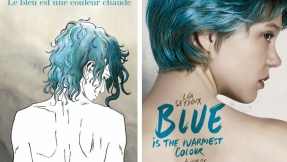
Blue is the Warmest Color is a love story that can dazzle many different kinds of people. With the beautiful and immersive artwork from Julie Muroh’s graphic novel, to the naturalistic and powerful filmmaking of Abdellatif Kechiche paired with wonderful and believable performances by Adele Exarchopolous and Lea Seydoux.
While anyone can appreciate the work and artistic merit that both versions present, both versions were made for a specific audience to enjoy the love story between the two women. Julie Muroh’s strong relatable protagonist and beautiful art work is inspiring and helpful to a young adult audience and allows them to connect with a lesbian character. Kechiche’s film can help bring this unique lesbian relationship to a more analytical audience who can appreciate the complexities and the reality between the love that the two women share with each other. Either way, both versions of Blue is the Warmest Color offer a powerful and realistic relationship between Clementine/Adele and Emma. The relationship is touching and allows the audience to connect with the characters in a touching and emotionally powerful way.
What do you think? Leave a comment.











I thought that the movie was very realistic in almost all aspects (even painfully so at times if I may add) but the unrealism of the sex scenes ruined it for me just a bit.
Adele’s sexual encounters with her first boyfriend and then Emma were nothing short of a porn flick. I don’t have problems with nudity or sexually explicit scenes at all (before anyone calls me a prude and thinks that the problem lies in that) but these ones were painful to watch for me simply because of how badly they fit in with the rest of the movie. I loved the movie as a whole but whenever a sex scene would creep up I felt like I was watching something about the sexual encounters of porn star. Those scenes didn’t portray a young girl who is trying to discover herself and her sexuality – at least in my opinion.
Now, I know that there are some people out there who would probably just watch this movie for the sex scenes (sad but true) and I’m wondering if the director did this intentionally to guarantee himself a larger audience. Since he managed to depict realism so well in all other aspects, it seems doubtful that he’d be so oblivious to the lack of realism in the sex scenes.
The sex scenes are definitely problematic in the film. I’m not really sure what Kechiche was thinking when he choose to have those scenes in that style in the film. The scenes are just really out of place in the rest of the film and the unnecessary length just emphasized that even more so. If they were even just shortened to a couple minutes at the most or something, I feel like it wouldn’t have been as bad. Really, I feel like Kechiche had some artistic vision (I have no idea what) and it didn’t come through in the end.
The scenes don’t ruin the film for me though because it is a three hour film with only ten minutes of those scenes. The other 170 minutes still adds a lot to the characterization of the Adele and Emma and the film still provides an emotionally powerful relationship between both of them.
I don’t think it ruined the realism; rather, I think it enhanced it to some degree. I can totally understand how the sex would be compared to porn, and I thought that they did run a bit lengthly, but then again, without those scenes, where would the passion be? How else would the audience know and understand the desire the girls had for each other? In my opinion, I thought they illustrated the intense passion and love they had for each other in a way that is hard to showcase in any other fashion. Plus, you gotta give the actresses a lot of credit – to do scenes that intense is pretty brave of them!
I wouldn’t get rid of the sex scenes at all. They do add a lot to show the love between the two characters and it helps understand the bond between the two characters.
However, the scenes are stylistically done very differently. While the rest of the film feels very natural and realistic, the sex scenes had an unrealistic lighting, there was a weird spot light on the bed, etc. So the scenes stylistically felt out of place and even if they were done naturally and realistically, the audience doesn’t need seven minutes nonstop of sex to understand the love and bond between the characters.
Great – thanks for writing! I would say, however, that Blue isn’t an LGBT film at all because it is made from a hetero perspective and is fairly cliched, 1D, and doesn’t contain anything new or interesting for LGBT/queer cinema.
I don’t think I called the film an LGBT film in the article. I cited LGBTQ in the tags since it does deal with LGBTQ issues. I didn’t mean to try and say that it was an LGBT film.
So if a gangster movie is made from a law-abiding person’s perspective and doesn’t contain anything new or interesting for the gangster genre, is not gangster movie?
An LGBT/queer film and LGBT cinema as terms imply that the film was made by someone who identifies as queer or LGBT. The difference between LGBT/queer and gangster is that being a gangster isn’t something that makes up who they are, they aren’t born with a gangster gene, etc.
I like very mach the first part of the story and find it very interesting easy an 8/10 but the second part just fell unnecessary and just like dragged the plot it was still goo but no as much as the first part. The story should had ended on the first part.
The reason the second half feels longer is because they didn’t really have a transition between when they were younger and when they were older. In the graphic novel, there is a scene where Clementine’s (Adele’s) parents find out that she is a lesbian and kick her out of their house and their life. In the graphic novel, this was the bridge between younger Clementine and Emma. They originally had this scene in the film, but had to cut it because of the length.
However, they couldn’t end the film after the first half because the story of Adele and Emma’s relationship wasn’t complete yet.
Ugly, unimaginative drivel about shallow, unlikable people eating spaghetti with their mouths open and having endless sex. Isn’t eroticism supposed to be artistic, or beautiful? What is happening to cinema? How did this piece of crap win the Palme D’or???
My theory is not that is the best movie there is (I agree that it’s not), but it’s not just that it has graphic sex either. Rather it’s because it is a very GOOD movie WITH fairly graphic sex. That’s unheard of in America and rare even in France these days. I’d say that even more so for the lead actress–it is rare to see an actress who is that beautiful, that talented, and yet willing to do these graphic sex scenes. So, yes, it is about the sex, of course, but it isn’t ONLY about the sex.
I liked the movie because I liked the OTHER 2 hours and 45 minutes. If it had just been three hours of lesbian action, I probably wouldn’t have gotton bored and I certainly wouldn’t admit to watching it let alone defend it. I didn’t read one laudatory review of it personally, so my opinion is definitely my own. The sex doesn’t necessarily make it good, but it doesn’t necessarily make it bad either. What I’m trying to say is it makes it possible. Nobody is going to watch a three-hour movie about lesbians except lesbians, and they’re just aren’t enough of them, so if they need to put in some hot sex and hot French girls to widen the audience, that’s understandable.
Lots of straight people are interested in and supportive of the LGBTQ community. Most people watch “Blue” for the story and interesting relationship and not for the sex scenes . . .
Some people (like author of this comment) will never stop to discredit and put down a rare film about women leading and representing themselves and their passion for the full duration of film on the big screen. They wont (or cant) see past the male point of view even when it’s a film about women, and cannot accept that the fact that the gender or orientation the filmmaker is irrelevant. It’s just sad because even some women (and some lesbians) fall in into this category. Even when it’s a film with strong lesbian interest, to them it’s only for the male eye and his viewing pleasure.
I have yet to watch this movie…after reading this I might have to check out both the movie and novel.
You should, they’re really good!
I think that anybody who tries to compare a movie to the original novel will find flaws. What people need to remember is that this is an adaptation of the original novel. I thought that this movie was great and the sex scenes, although they were long, were not pornographic and not degrading, I think that Americans are just easily unnerved by sex scenes.
That’s funny because the actresses were degraded in the filming process and said so themselves
Hi there
I only just finished watching the movie and wanted to read up on the adaption properly. So even though I gave suggestions for your article originally, I really appreciate your straight forward way of explaining it. I wonder why the director decided to change the ending…. it is a tad more optimistic than the graphic novel, though.
I was expecting worse for the sex scenes, funnily enough, so they didn’t really bother me.
Thanks for an interesting article.
Idiot. The strawberry milk ordered in the bar is an alcoholic drink stop reading into it. It’s an actual drink called adult strawberry milk. Nothing fancy. How many bars do you know that carry actual strawberry milk and have it just laying around on the off chance that someone is gonna come in and want to indulge in a treat from when they were 5?